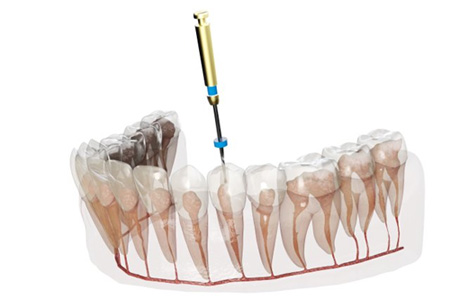Root Canal Treatment – San Jose, CA
Get Your Healthy, Pain-Free Smile Back

Do you feel a sharp, stabbing pain when you bite down? Is there a pimple-like bump on your gums? Are your gums bleeding when you floss? If so, you might need a root canal. Before you panic, it’s important to know that this procedure is nowhere near as scary as its reputation. Plus, our talented dentist, Dr. Kelly Thanh, is here to make the entire treatment process as smooth and stress-free as possible. If you’re ready to schedule an appointment, then give us a call. If you want to learn more about this restorative dental treatment first, then read on!
Why Choose Dr. Kelly Thanh for Root Canal Treatment?
- Dentist with 25+ Years of Experience
- Root ZX Is Used for Increased Precision
- Convenient Hours, Including Evenings
Do You Need Root Canal Treatment?

Here are a few common warning signs that a root canal is needed:
- Dull, consistent discomfort
- Sharp, stabbing pain
- A pimple-like bump on the gums
- Dark discoloration on the tooth in question
- Red, inflamed, or bleeding gums
It’s also important that we mention here that – even if your toothache goes away – you should schedule an appointment with us. This is crucial because a toothache that has gone radio silent is usually the result of the nerve dying, and there is only a small window of time when saving your tooth is still possible. So, don’t continue to take the “wait and see” approach!
The Root Canal Process

Whether Dr. Thanh is treating one tooth or several teeth, the first step is always the same: to numb your mouth. Once you’re comfortable and ready to begin, she will make a small hole in your tooth before removing the damaged, infected, and decayed particles. Then, she will thoroughly sanitize the area, fill the tooth with a warm, rubbery substance, and seal off the access hole. The last step is placing a dental crown over the tooth.
The Benefits of Getting a Root Canal

For many patients, just hearing the words “root canal” causes them to panic. However, there are several noteworthy perks of this restorative treatment, including:
- It’s Virtually Painless – Since your mouth is numbed beforehand, you won’t feel any discomfort in the treatment chair.
- It Can Save Your Tooth – Not only do root canals prevent the need for an extraction, but they also have an incredibly high success rate.
- The Final Result Is Lifelike In Every Way – Dental crowns today are crafted from natural-looking materials and custom-made for each patient, making them look and feel incredible.
If you have any questions for us, or you’re ready to schedule your appointment, don’t hesitate to take the next step: get in touch with our friendly and helpful team!
Understanding the Cost of Root Canals

When determining the cost of root canal treatment, Dr. Thanh and our team must examine the affected area before establishing a proposed plan or price point. This scheduled consultation ensures that you receive the clearest, most accurate information, and it provides a better understanding of how much you can expect the procedure to cost. Our team will be happy to go over the available payment options we offer in-house, as well as work to maximize your dental benefits to help you save.
Factors That Can Affect Root Canal Cost

Dr. Thanh will need to closely examine your affected tooth during a consultation. She will consider the following factors before drafting a cost estimate for treatment:
- Whether the procedure can be performed by an in-house dentist or an outside specialist. Most root canals can be treated by Dr. Thanh; however, in rare instances, we may need to bring in an endodontist.
- The location of the affected tooth. Treating a tooth toward the front of the mouth will cost much less than a molar, which is found in the back. The reason is that chewing teeth (molars) have multiple canals, so they take longer to treat.
- If you require additional services. Most patients who receive a root canal will need a custom dental crown. This ensures that the tooth is properly protected over time, allowing it to strengthen and function normally.
Is It Cheaper to Pull My Tooth?

You might assume it would be easier and less expensive to remove the damaged or decayed tooth, but the reality is that a root canal is much more cost-effective. Tooth extraction not only comes with its own price, but the amount you will spend to replace and maintain a dental bridge, partial denture, or dental implant can add up.
A root canal, however, has a high success rate, which means it is usually performed only once. Only in extremely rare cases does a dentist need to reopen a previously treated tooth.
Does Dental Insurance Cover Root Canals?

Generally, dental insurance companies do offer coverage for root canals. Although each plan and policy is different, this type of restorative care is considered medically necessary, which means it is usually covered. When reviewing your plan, or having a member of staff do it for you, you’ll discover that as long as you’ve met your annual deductible, your insurance company may pay between 50-80% of the total bill. Much of this depends on your annual maximum, though.
Other Options for Making Root Canal Therapy Affordable

Since dental insurance companies will not pay for your root canal in full, you will be required to pay a portion out of pocket. To help with these expenses, you can enroll in a plan through CareCredit. The process is similar to using a credit card. When applying, you can choose from one of their many low- or no-interest plans, each with varying lengths. Once you are approved, you can pay off the full amount upfront with your CareCredit card. Over time, you will make manageable monthly payments, allowing you to stay within budget and avoid surprise fees along the way.
